Multiple Access Techniques in Wireless Communication
VerifiedAdded on 2020/03/02
|7
|1274
|300
AI Summary
This assignment explores the concepts of Frequency Division Multiple Access (FDMA) and Code Division Multiple Access (CDMA), two key techniques used in wireless communication. It provides a detailed comparison of these methods, highlighting their characteristics, advantages, and disadvantages. The document analyzes how FDMA allocates space within the radio spectrum using sub-band frequencies, while CDMA employs codes to identify and separate signals. A table summarizes the differences between the two techniques, covering aspects like signal identification, bandwidth usage, idle time, and common applications.
Contribute Materials
Your contribution can guide someone’s learning journey. Share your
documents today.
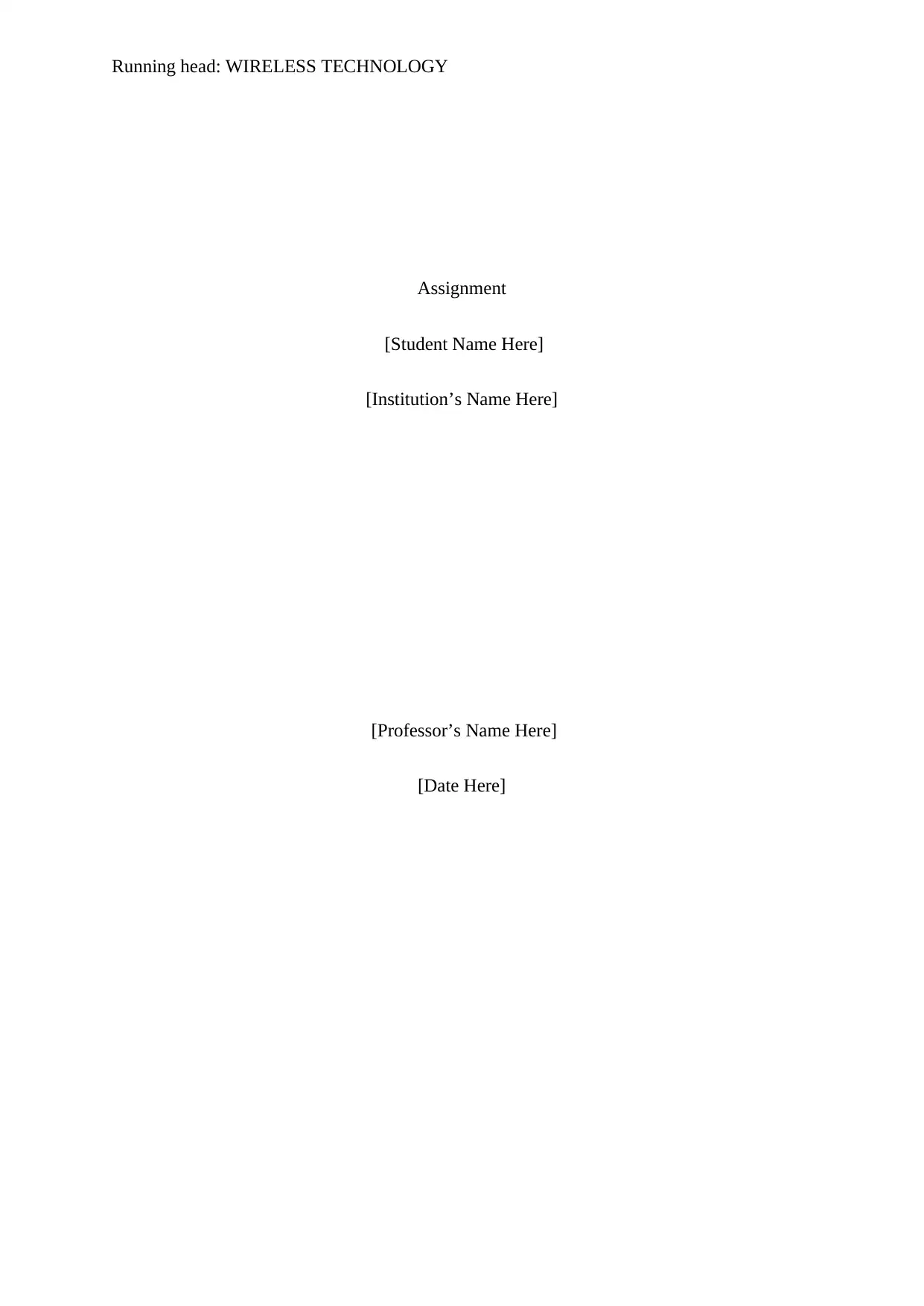
Running head: WIRELESS TECHNOLOGY
Assignment
[Student Name Here]
[Institution’s Name Here]
[Professor’s Name Here]
[Date Here]
Assignment
[Student Name Here]
[Institution’s Name Here]
[Professor’s Name Here]
[Date Here]
Secure Best Marks with AI Grader
Need help grading? Try our AI Grader for instant feedback on your assignments.
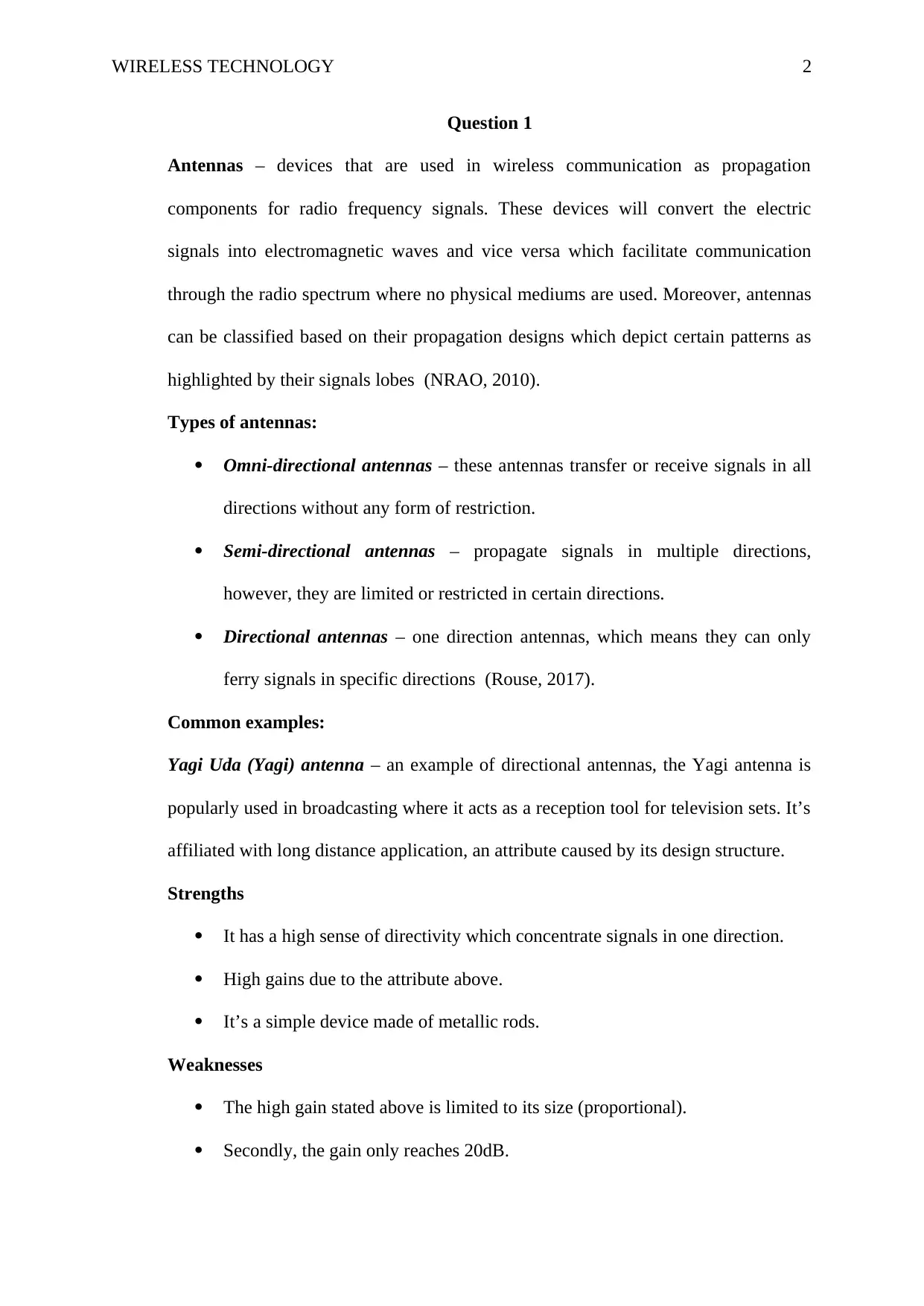
WIRELESS TECHNOLOGY 2
Question 1
Antennas – devices that are used in wireless communication as propagation
components for radio frequency signals. These devices will convert the electric
signals into electromagnetic waves and vice versa which facilitate communication
through the radio spectrum where no physical mediums are used. Moreover, antennas
can be classified based on their propagation designs which depict certain patterns as
highlighted by their signals lobes (NRAO, 2010).
Types of antennas:
Omni-directional antennas – these antennas transfer or receive signals in all
directions without any form of restriction.
Semi-directional antennas – propagate signals in multiple directions,
however, they are limited or restricted in certain directions.
Directional antennas – one direction antennas, which means they can only
ferry signals in specific directions (Rouse, 2017).
Common examples:
Yagi Uda (Yagi) antenna – an example of directional antennas, the Yagi antenna is
popularly used in broadcasting where it acts as a reception tool for television sets. It’s
affiliated with long distance application, an attribute caused by its design structure.
Strengths
It has a high sense of directivity which concentrate signals in one direction.
High gains due to the attribute above.
It’s a simple device made of metallic rods.
Weaknesses
The high gain stated above is limited to its size (proportional).
Secondly, the gain only reaches 20dB.
Question 1
Antennas – devices that are used in wireless communication as propagation
components for radio frequency signals. These devices will convert the electric
signals into electromagnetic waves and vice versa which facilitate communication
through the radio spectrum where no physical mediums are used. Moreover, antennas
can be classified based on their propagation designs which depict certain patterns as
highlighted by their signals lobes (NRAO, 2010).
Types of antennas:
Omni-directional antennas – these antennas transfer or receive signals in all
directions without any form of restriction.
Semi-directional antennas – propagate signals in multiple directions,
however, they are limited or restricted in certain directions.
Directional antennas – one direction antennas, which means they can only
ferry signals in specific directions (Rouse, 2017).
Common examples:
Yagi Uda (Yagi) antenna – an example of directional antennas, the Yagi antenna is
popularly used in broadcasting where it acts as a reception tool for television sets. It’s
affiliated with long distance application, an attribute caused by its design structure.
Strengths
It has a high sense of directivity which concentrate signals in one direction.
High gains due to the attribute above.
It’s a simple device made of metallic rods.
Weaknesses
The high gain stated above is limited to its size (proportional).
Secondly, the gain only reaches 20dB.
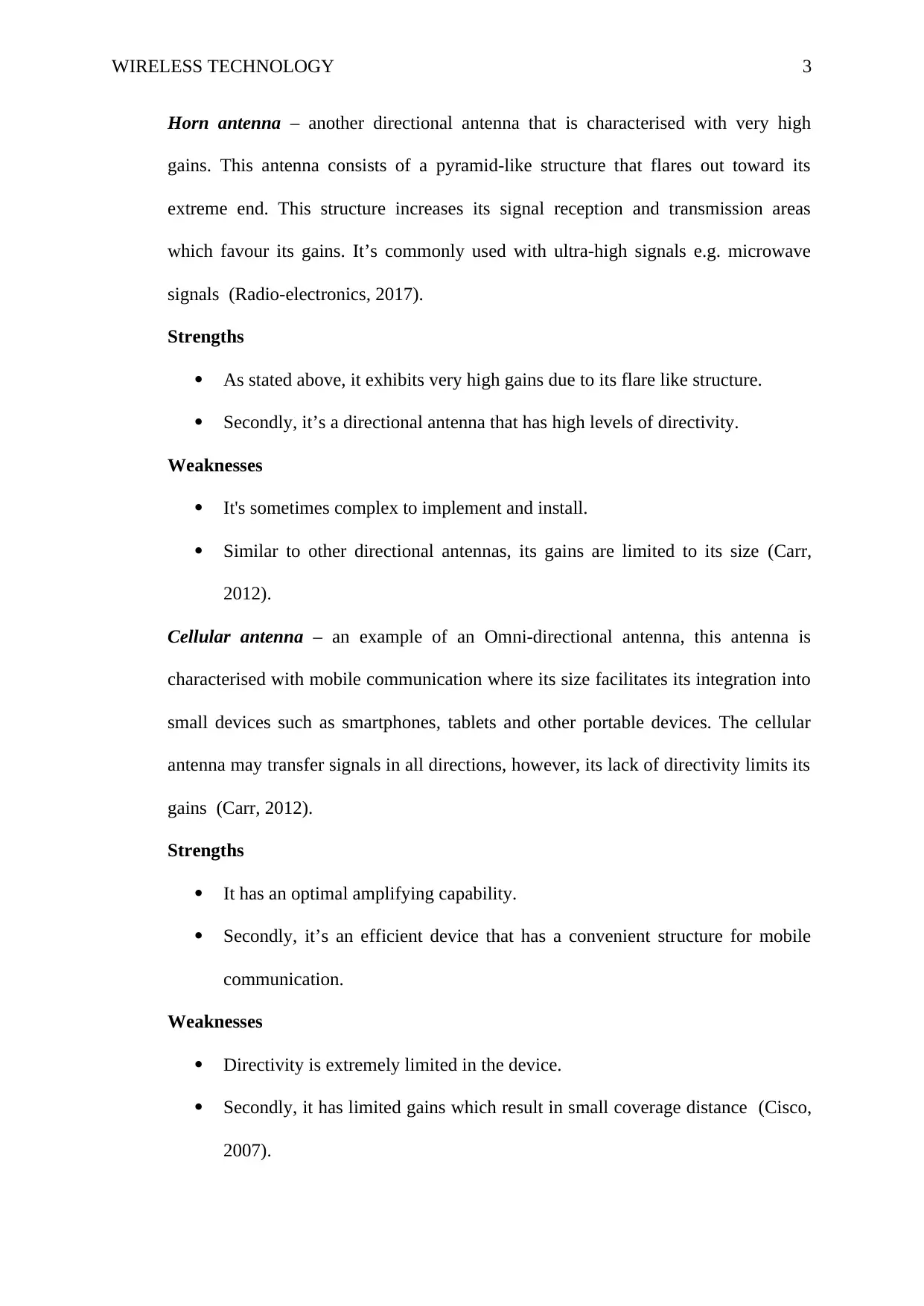
WIRELESS TECHNOLOGY 3
Horn antenna – another directional antenna that is characterised with very high
gains. This antenna consists of a pyramid-like structure that flares out toward its
extreme end. This structure increases its signal reception and transmission areas
which favour its gains. It’s commonly used with ultra-high signals e.g. microwave
signals (Radio-electronics, 2017).
Strengths
As stated above, it exhibits very high gains due to its flare like structure.
Secondly, it’s a directional antenna that has high levels of directivity.
Weaknesses
It's sometimes complex to implement and install.
Similar to other directional antennas, its gains are limited to its size (Carr,
2012).
Cellular antenna – an example of an Omni-directional antenna, this antenna is
characterised with mobile communication where its size facilitates its integration into
small devices such as smartphones, tablets and other portable devices. The cellular
antenna may transfer signals in all directions, however, its lack of directivity limits its
gains (Carr, 2012).
Strengths
It has an optimal amplifying capability.
Secondly, it’s an efficient device that has a convenient structure for mobile
communication.
Weaknesses
Directivity is extremely limited in the device.
Secondly, it has limited gains which result in small coverage distance (Cisco,
2007).
Horn antenna – another directional antenna that is characterised with very high
gains. This antenna consists of a pyramid-like structure that flares out toward its
extreme end. This structure increases its signal reception and transmission areas
which favour its gains. It’s commonly used with ultra-high signals e.g. microwave
signals (Radio-electronics, 2017).
Strengths
As stated above, it exhibits very high gains due to its flare like structure.
Secondly, it’s a directional antenna that has high levels of directivity.
Weaknesses
It's sometimes complex to implement and install.
Similar to other directional antennas, its gains are limited to its size (Carr,
2012).
Cellular antenna – an example of an Omni-directional antenna, this antenna is
characterised with mobile communication where its size facilitates its integration into
small devices such as smartphones, tablets and other portable devices. The cellular
antenna may transfer signals in all directions, however, its lack of directivity limits its
gains (Carr, 2012).
Strengths
It has an optimal amplifying capability.
Secondly, it’s an efficient device that has a convenient structure for mobile
communication.
Weaknesses
Directivity is extremely limited in the device.
Secondly, it has limited gains which result in small coverage distance (Cisco,
2007).
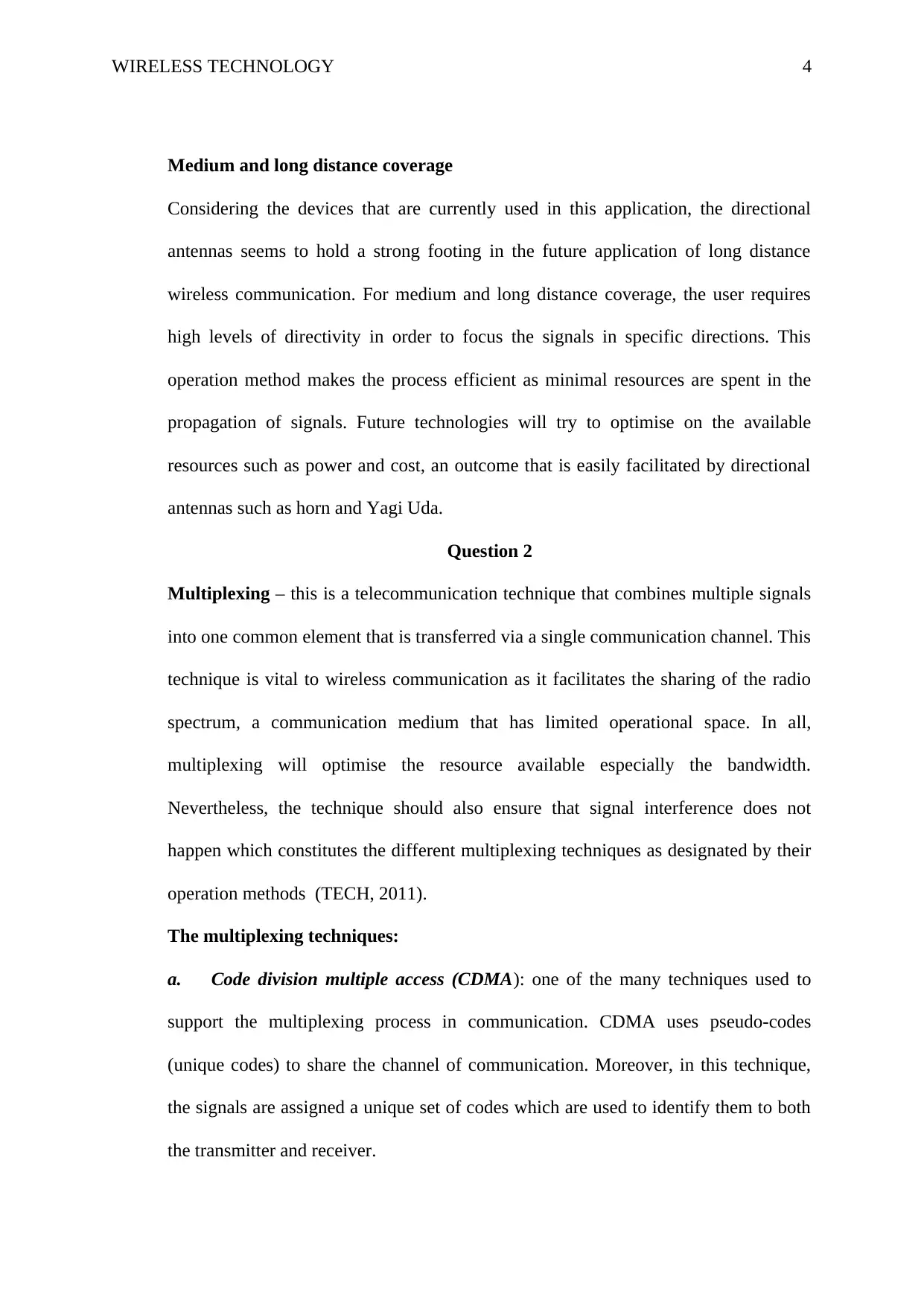
WIRELESS TECHNOLOGY 4
Medium and long distance coverage
Considering the devices that are currently used in this application, the directional
antennas seems to hold a strong footing in the future application of long distance
wireless communication. For medium and long distance coverage, the user requires
high levels of directivity in order to focus the signals in specific directions. This
operation method makes the process efficient as minimal resources are spent in the
propagation of signals. Future technologies will try to optimise on the available
resources such as power and cost, an outcome that is easily facilitated by directional
antennas such as horn and Yagi Uda.
Question 2
Multiplexing – this is a telecommunication technique that combines multiple signals
into one common element that is transferred via a single communication channel. This
technique is vital to wireless communication as it facilitates the sharing of the radio
spectrum, a communication medium that has limited operational space. In all,
multiplexing will optimise the resource available especially the bandwidth.
Nevertheless, the technique should also ensure that signal interference does not
happen which constitutes the different multiplexing techniques as designated by their
operation methods (TECH, 2011).
The multiplexing techniques:
a. Code division multiple access (CDMA): one of the many techniques used to
support the multiplexing process in communication. CDMA uses pseudo-codes
(unique codes) to share the channel of communication. Moreover, in this technique,
the signals are assigned a unique set of codes which are used to identify them to both
the transmitter and receiver.
Medium and long distance coverage
Considering the devices that are currently used in this application, the directional
antennas seems to hold a strong footing in the future application of long distance
wireless communication. For medium and long distance coverage, the user requires
high levels of directivity in order to focus the signals in specific directions. This
operation method makes the process efficient as minimal resources are spent in the
propagation of signals. Future technologies will try to optimise on the available
resources such as power and cost, an outcome that is easily facilitated by directional
antennas such as horn and Yagi Uda.
Question 2
Multiplexing – this is a telecommunication technique that combines multiple signals
into one common element that is transferred via a single communication channel. This
technique is vital to wireless communication as it facilitates the sharing of the radio
spectrum, a communication medium that has limited operational space. In all,
multiplexing will optimise the resource available especially the bandwidth.
Nevertheless, the technique should also ensure that signal interference does not
happen which constitutes the different multiplexing techniques as designated by their
operation methods (TECH, 2011).
The multiplexing techniques:
a. Code division multiple access (CDMA): one of the many techniques used to
support the multiplexing process in communication. CDMA uses pseudo-codes
(unique codes) to share the channel of communication. Moreover, in this technique,
the signals are assigned a unique set of codes which are used to identify them to both
the transmitter and receiver.
Secure Best Marks with AI Grader
Need help grading? Try our AI Grader for instant feedback on your assignments.
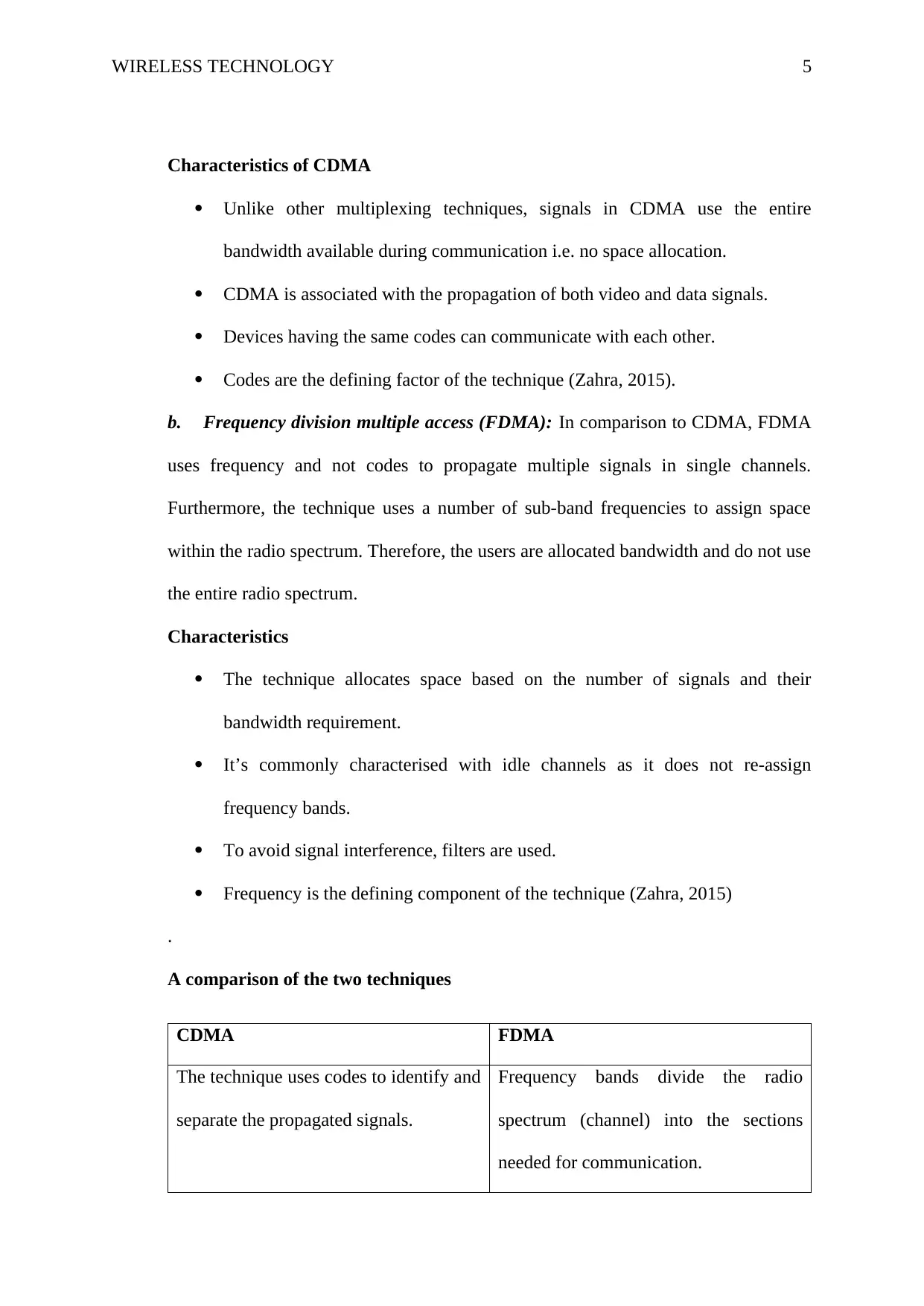
WIRELESS TECHNOLOGY 5
Characteristics of CDMA
Unlike other multiplexing techniques, signals in CDMA use the entire
bandwidth available during communication i.e. no space allocation.
CDMA is associated with the propagation of both video and data signals.
Devices having the same codes can communicate with each other.
Codes are the defining factor of the technique (Zahra, 2015).
b. Frequency division multiple access (FDMA): In comparison to CDMA, FDMA
uses frequency and not codes to propagate multiple signals in single channels.
Furthermore, the technique uses a number of sub-band frequencies to assign space
within the radio spectrum. Therefore, the users are allocated bandwidth and do not use
the entire radio spectrum.
Characteristics
The technique allocates space based on the number of signals and their
bandwidth requirement.
It’s commonly characterised with idle channels as it does not re-assign
frequency bands.
To avoid signal interference, filters are used.
Frequency is the defining component of the technique (Zahra, 2015)
.
A comparison of the two techniques
CDMA FDMA
The technique uses codes to identify and
separate the propagated signals.
Frequency bands divide the radio
spectrum (channel) into the sections
needed for communication.
Characteristics of CDMA
Unlike other multiplexing techniques, signals in CDMA use the entire
bandwidth available during communication i.e. no space allocation.
CDMA is associated with the propagation of both video and data signals.
Devices having the same codes can communicate with each other.
Codes are the defining factor of the technique (Zahra, 2015).
b. Frequency division multiple access (FDMA): In comparison to CDMA, FDMA
uses frequency and not codes to propagate multiple signals in single channels.
Furthermore, the technique uses a number of sub-band frequencies to assign space
within the radio spectrum. Therefore, the users are allocated bandwidth and do not use
the entire radio spectrum.
Characteristics
The technique allocates space based on the number of signals and their
bandwidth requirement.
It’s commonly characterised with idle channels as it does not re-assign
frequency bands.
To avoid signal interference, filters are used.
Frequency is the defining component of the technique (Zahra, 2015)
.
A comparison of the two techniques
CDMA FDMA
The technique uses codes to identify and
separate the propagated signals.
Frequency bands divide the radio
spectrum (channel) into the sections
needed for communication.
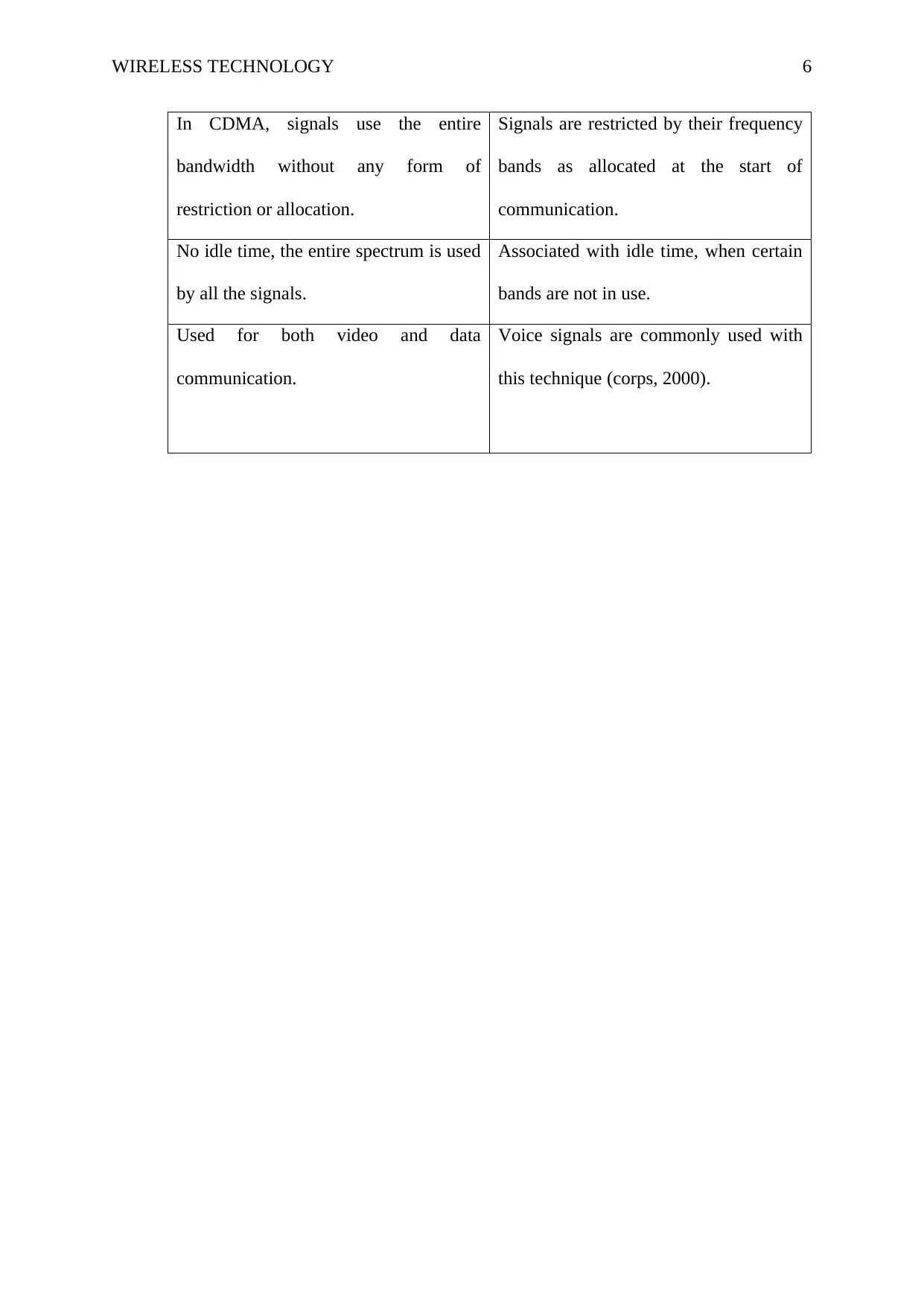
WIRELESS TECHNOLOGY 6
In CDMA, signals use the entire
bandwidth without any form of
restriction or allocation.
Signals are restricted by their frequency
bands as allocated at the start of
communication.
No idle time, the entire spectrum is used
by all the signals.
Associated with idle time, when certain
bands are not in use.
Used for both video and data
communication.
Voice signals are commonly used with
this technique (corps, 2000).
In CDMA, signals use the entire
bandwidth without any form of
restriction or allocation.
Signals are restricted by their frequency
bands as allocated at the start of
communication.
No idle time, the entire spectrum is used
by all the signals.
Associated with idle time, when certain
bands are not in use.
Used for both video and data
communication.
Voice signals are commonly used with
this technique (corps, 2000).
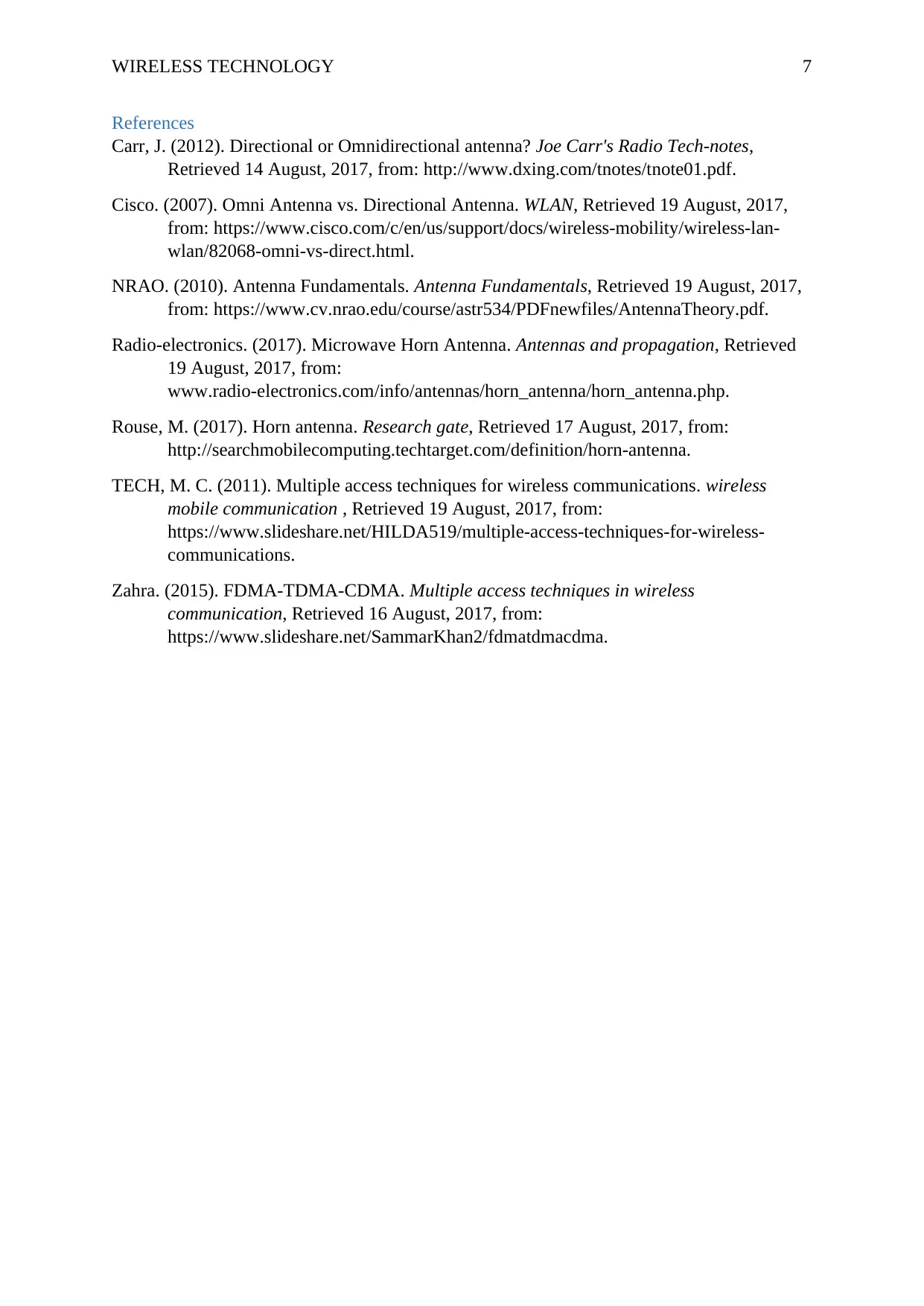
WIRELESS TECHNOLOGY 7
References
Carr, J. (2012). Directional or Omnidirectional antenna? Joe Carr's Radio Tech-notes,
Retrieved 14 August, 2017, from: http://www.dxing.com/tnotes/tnote01.pdf.
Cisco. (2007). Omni Antenna vs. Directional Antenna. WLAN, Retrieved 19 August, 2017,
from: https://www.cisco.com/c/en/us/support/docs/wireless-mobility/wireless-lan-
wlan/82068-omni-vs-direct.html.
NRAO. (2010). Antenna Fundamentals. Antenna Fundamentals, Retrieved 19 August, 2017,
from: https://www.cv.nrao.edu/course/astr534/PDFnewfiles/AntennaTheory.pdf.
Radio-electronics. (2017). Microwave Horn Antenna. Antennas and propagation, Retrieved
19 August, 2017, from:
www.radio-electronics.com/info/antennas/horn_antenna/horn_antenna.php.
Rouse, M. (2017). Horn antenna. Research gate, Retrieved 17 August, 2017, from:
http://searchmobilecomputing.techtarget.com/definition/horn-antenna.
TECH, M. C. (2011). Multiple access techniques for wireless communications. wireless
mobile communication , Retrieved 19 August, 2017, from:
https://www.slideshare.net/HILDA519/multiple-access-techniques-for-wireless-
communications.
Zahra. (2015). FDMA-TDMA-CDMA. Multiple access techniques in wireless
communication, Retrieved 16 August, 2017, from:
https://www.slideshare.net/SammarKhan2/fdmatdmacdma.
References
Carr, J. (2012). Directional or Omnidirectional antenna? Joe Carr's Radio Tech-notes,
Retrieved 14 August, 2017, from: http://www.dxing.com/tnotes/tnote01.pdf.
Cisco. (2007). Omni Antenna vs. Directional Antenna. WLAN, Retrieved 19 August, 2017,
from: https://www.cisco.com/c/en/us/support/docs/wireless-mobility/wireless-lan-
wlan/82068-omni-vs-direct.html.
NRAO. (2010). Antenna Fundamentals. Antenna Fundamentals, Retrieved 19 August, 2017,
from: https://www.cv.nrao.edu/course/astr534/PDFnewfiles/AntennaTheory.pdf.
Radio-electronics. (2017). Microwave Horn Antenna. Antennas and propagation, Retrieved
19 August, 2017, from:
www.radio-electronics.com/info/antennas/horn_antenna/horn_antenna.php.
Rouse, M. (2017). Horn antenna. Research gate, Retrieved 17 August, 2017, from:
http://searchmobilecomputing.techtarget.com/definition/horn-antenna.
TECH, M. C. (2011). Multiple access techniques for wireless communications. wireless
mobile communication , Retrieved 19 August, 2017, from:
https://www.slideshare.net/HILDA519/multiple-access-techniques-for-wireless-
communications.
Zahra. (2015). FDMA-TDMA-CDMA. Multiple access techniques in wireless
communication, Retrieved 16 August, 2017, from:
https://www.slideshare.net/SammarKhan2/fdmatdmacdma.
1 out of 7
Related Documents
Your All-in-One AI-Powered Toolkit for Academic Success.
+13062052269
info@desklib.com
Available 24*7 on WhatsApp / Email
![[object Object]](/_next/static/media/star-bottom.7253800d.svg)
Unlock your academic potential
© 2024 | Zucol Services PVT LTD | All rights reserved.





